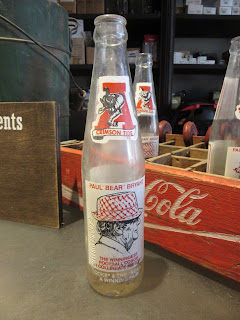Thursday, 2/10/2022
35 degrees this morning and we go to a nearby McDonalds for a breakfast sandwich and coffee. We meander through some of the Florida panhandle as we continue into rural Alabama to the town of Enterprise - home of a statue of the boll weevil.
We almost missed it, but soon discovered it in the center of main street, surrounded by a small fountain. We read a plaque which sort of explains the why of the statue, but when we go into the Weevil Nuts and Candy store, we get a nice history from the salesman there.
Next we head to Dothan, Alabama - the peanut capital of the world! 80% of US Peanuts are grown within 100 miles of Dothan. (Jimmy Carter's Plains, GA included. We've been there before.)They had lots of murals throughout downtown.
This mural depicts the Dothan Riot . In 1889, a skirmish arose over a tax which the town instigated on heavy wagons passing through the town, which of course the cotton farmers objected to. Two were killed and several wounded, but the tax still exists today.
This is a hometown boy who made good. Johnny Mack Brown was an outstanding athlete and western movie star.Other murals showed the importance of the Civil War, turpentine making, peanuts, railroads and a more modern award-winning marching band and country music performers. And there were more.

Also in Dothan, was E.R. Porter Hardware Co. Established in 1889, it is now maintained as a museum of sorts by a descendant who enjoyed sharing photos and stories. Beautiful tin ceiling in the building, as well as ladders on wheels to reach the high shelves. Lots of old hardware, boxes and supplies. Thought this Bear Bryant coke bottle was kind of neat.

We spy a few of the painted peanuts scattered throughout town. Can't say this town isn't trying!
We tried to go to the George Washington Carver museum here, but it was closed even though the signs indicated it should have been open. There is another in Tuskegee...
Some cute clever names along the way, like a storage container company advertising "Mobile Attics", and Dirty Hands Farm. There are quite a few farms with cattle as well, and we bypass a local "Moo-seum". A few Trump signs here and there.
Todd's Farms was the next stop. They were supposed to show how Syrup is made from sugar cane. The large store with cafe was open, but unfortunately the syrup demonstration area was closed due to illness of the owner. The season for making the syrup is October-November.
Next stop was the Octagon House in Clayton, Alabama. Built in 1859, it was quite unusual and pretty, but - you guessed it - CLOSED. We walked around the back porch and found the back door open, but guessed it shouldn't have been, so left.
We walked down the street to the city cemetery where there is a tombstone in the shape of a whisky bottle. No story, but we read that it was put up by a widow whose husband drank himself to death. Couldn't read the inscription... People have left coins there, as we have seen numerous times in numerous locations - just as an acknowledgement. Greg added one.We've discovered we are in Wiregrass Country, after passing Wiregrass Hardware, Wiregrass Mechanics, etc. The Wiregrass region or Wiregrass country is an area made of parts of southern Georgia, southeastern Alabama and the Florida panhandle, named for native wire grass. (The portion of US84 through Georgia is known as the Wiregrass Georgia Parkway.) Here's wire grass near Tuskegee.
We planned to spend the night in the Tuskegee National Forest north of here. The first site we come to has a bit of charred ground and a sign that said they were doing preventative burns -dated yesterday. There was a faint smell of smoke. We thought we'd stay anyway, but after walking a bit we noticed there were still a few spots of smoldering brush with a few flames, so we moved a few miles away to a safer spot. We had a map which showed 14 different primitive spots for camping here. Nothing fancy, but quiet and wooded.We haven't seen many animals in our wanderings through the countryside. A few birds, a turkey, a single deer. There are current as well as older signs of clear cutting of pine trees. Lumber is big business across the south, we discover. Some of the clear cut areas had random stumps and brush piles with muddy tracks, while others were better cleared and cleaned - ready for new growth.




















































